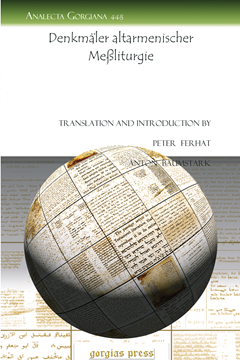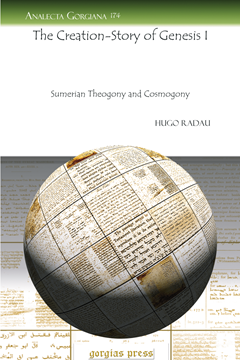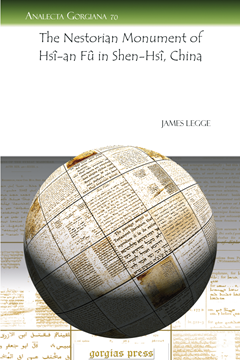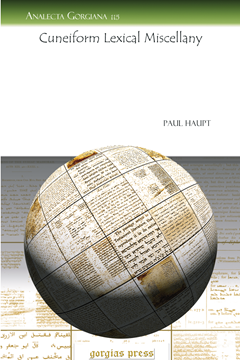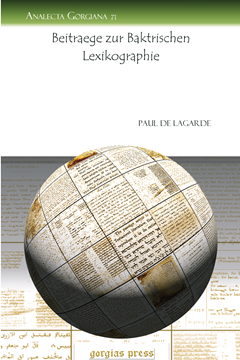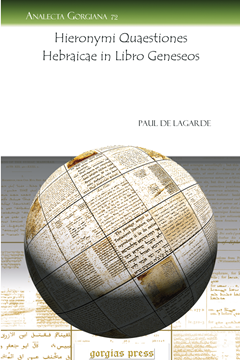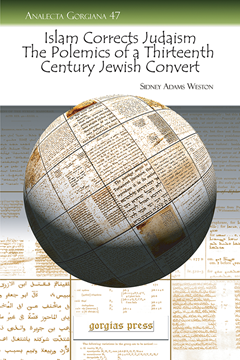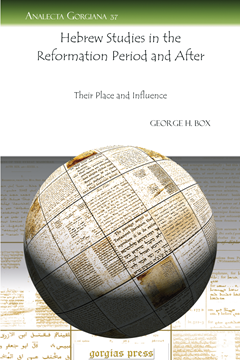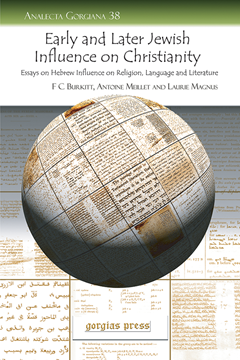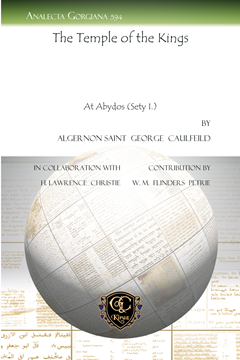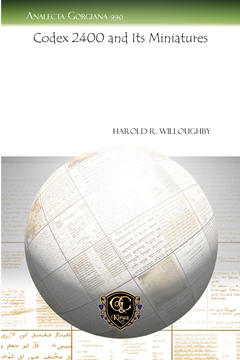Analecta Gorgiana
Analecta Gorgiana is a collection of long essays and short monographs which are consistently cited by modern scholars but previously difficult to find because of their original appearance in obscure publications. Carefully selected by a team of scholars based on their relevance to modern scholarship, these essays can now be fully utilized by scholars and proudly owned by libraries.
Die Haggadischen Elemente in den Homilien des Aphraates, des persischen Weisen
By Salomon Funk
Series: Analecta Gorgiana 489
ISBN: 978-1-60724-967-2
In this volume, Funk addresses questions concerning Aphrahat’s possible relationship to Jewish sources. His method in the main part is to go through biblical passages that Aphrahat comments on and show parallels with rabbinic literature.
$47.00 (USD) $28.20 (USD)
Denkmäler altarmenischer Meßliturgie
Translation and Introduction by Peter Ferhat & Anton Baumstark
Series: Analecta Gorgiana 448
ISBN: 978-1-60724-882-8
Joseph Catergian’s Die Liturgien bei den Armeniern was significant for liturgical studies in the Armenian tradition, but it lacked translations of the texts. The present publication includes translations by Peter Ferhart, Anton Baumstark, and Adolf Rücker.
$47.00 (USD) $28.20 (USD)
The Sequence of Tenses in Latin
Series: Analecta Gorgiana 324
ISBN: 978-1-60724-556-8
In this well-known piece, Hale questions the rule of sequence of tense in Latin subjunctive clauses which is still used to teach Latin grammar, but fails to correspond to the language as it was used by the Romans themselves.
$47.00 (USD) $28.20 (USD)
Introduction of Gothic Architecture into Italy by the French Cistercian Monks.
Series: Analecta Gorgiana 267
ISBN: 978-1-60724-496-7
This series of papers shows that a group of monuments erected by the French Cistercian monks, and here for the first time fully described and illustrated, were the earliest Italian buildings using transitional-Gothic architecture.
$47.00 (USD) $28.20 (USD)
The Sahidic Translation of the Book of Job
Series: Analecta Gorgiana 178
ISBN: 978-1-60724-271-0
Generally considered the leading pre-Islamic dialect of Coptic, Sahidic is an important language for Orientalists. Perhaps because of its body of original, non-translated material, Sahidic is the Coptic dialect most commonly studied outside of ecclesiastical settings. Sahidic, however, is also used as a language of translation, as in this booklet containing the biblical book of Job in that dialect. Unparalleled as a source for beginners in Coptic, this small portion of the Bible presents a familiar starting point. Coptic scholars will also find this resource worth their time as an historical example of the language and its study. Known also as Thebaic, this form of Coptic was used for translating major portions of the Bible. Since it was used by the church as well, this tract will be of interest to biblical scholars as well.
$47.00 (USD) $28.20 (USD)
Arabian Wisdom
Series: Analecta Gorgiana 195
ISBN: 978-1-60724-295-6
Having lived for many years in Beirut, John Wortabet grew to know much about the Islamic world. Recognizing the wisdom and integrity of the people and religion of what was then known as Syria, Wortabet set about to preserve the essentials of Arabic wisdom in this little book. The wisdom saying, a literary form of ancient pedigree in this part of the world, is generally a brief but pointed statement of a truth distilled from careful observation. Wortabet here presents these saying arranged according to topic, with the goal of facilitating understanding between the wider world and those who live in what has become a very unsettled region.
$47.00 (USD) $28.20 (USD)
The Creation-Story of Genesis I
Sumerian Theogony and Cosmogony
By Hugo Radau
Series: Analecta Gorgiana 174
ISBN: 978-1-60724-245-1
In this brief study of the creation account in Genesis 1, Radau makes full use of the Sumerian materials available in his day. Summarizing the sea monster versus deity scenario known from the Enuma Elish’s account of Marduk against Tiamat, he shows how Yahweh fits this role in Genesis 1. Going into linguistic detail of the Hebrew and Sumerian sources, he draws a set of correlations between the two.
$47.00 (USD) $28.20 (USD)
The Nestorian Monument of Hsî-an Fû in Shen-Hsî, China
By James Legge
Series: Analecta Gorgiana 70
ISBN: 978-1-59333-886-2
The “Nestorian Monument” or “Nestorian Stele” is a fascinating attestation of the work of Syriac-speaking missionaries in sixth-century China. Commemorating the diffusion of Christianity in China from 635-781, the inscription was erected in the latter year as a public monument. The inscription in Chinese, supplemented with some Syriac, provides a brief outline of Christian doctrine and provides an account of how Christianity came to China. This book offers an English translation of the monument along with the original language text.
$47.00 (USD) $28.20 (USD)
Die Briefe Hammurabi’s an Sin-Idinnam
Series: Analecta Gorgiana 101
ISBN: 978-1-60724-025-9
In keeping with the general format of nineteenth-century Assyriological publications, this study provides an abundance of information on the texts under consideration. Here, the correspondence between the famous Babylonian king Hammurabi and the governor of Larsa, Sin-Idinnam, is examined in detail. Nagel also includes commentary, beginning with grammatical and syntactical issues. Next he turns to lexical issues, beginning with individual words, compound words, and ideograms. Friedrich Delitzsch also adds further remarks to Nagel’s adequate analysis of these historically significant texts.
$47.00 (USD) $28.20 (USD)
History of the Printed Editions of the Old Testament
Series: Analecta Gorgiana 78
ISBN: 978-1-59333-891-6
Offering a comprehensive study of the history of the recensions of the Hebrew Bible down to the author’s day, this essay provides the reader with a veritable genealogy of the different versions of the Hebrew Scriptures.
$47.00 (USD) $28.20 (USD)
Cuneiform Lexical Miscellany
By Paul Haupt
Series: Analecta Gorgiana 115
ISBN: 978-1-60724-047-1
The cuneiform terms for sport introduce these studies on a variety of topics dealing with Akkadian and Sumerian lexicography. Other essays include an exploration of a cuneiform description of a volcanic eruption, the Assyrian words pâtu (blowy), pâţu (brim), miţpânu (longbow), talîmu (full brother), budulxu (bdellium), zâzu (halve), marçu (sick and arduous), xamâdu (to help), napšu (lust), and kamâsu, kanâšu, and qamâçu. Semitic and Classical descriptions of naphtha and asphalt, and a study of the cuneiform name of the home of ‘Omar Khayyâm are included. Sumerian lexicography is not neglected, with explorations of nimur (salt, smoke, salt-swamp), and azalak (fuller).
$48.00 (USD) $28.80 (USD)
Beitraege zur Baktrischen Lexikographie
Series: Analecta Gorgiana 71
ISBN: 978-1-59333-963-0
One of the few scholars of biblical languages to reach so far into the cultural world of antiquity, de Lagarde here offers a brief contribution to the study of Bactrian lexicography. This brief study grew out of the author’s long-standing appreciation for the related Persian languages and literature. While not a full-fledged dictionary, de Lagarde here provides discussions of over one hundred words, some of them offered in considerable detail. For the linguist interested in the history of the study of this particular language, this handbook will prove an invaluable tool.
$48.00 (USD) $28.80 (USD)
Hieronymi Quaestiones Hebraicae in Libro Geneseos
Series: Analecta Gorgiana 72
ISBN: 978-1-59333-964-7
Written in the scholarly Latin of his day, Lagarde considers in this brief study the questions Jerome raises on the Hebrew of the book of Genesis. In an abridged commentary form, Lagarde follows the questions in the order in which the book of Genesis presents the material. Beginning with the creation, Lagarde skips along to the phrases of Jerome’s text that raise questions and provides his insights about them. Presuming that the reader of the Vulgate will understand the Latin of the original, the comments on the material are likewise written in Latin.
$48.00 (USD) $28.80 (USD)
Islam Corrects Judaism
The Polemics of a Thirteenth Century Jewish Convert
Series: Analecta Gorgiana 47
ISBN: 978-1-59333-862-6
Herein a 13th century Alexandrian Jewish convert to Islam records his understanding of the truth of Islam over Judaism. Dr. Sidney A. Weston edits, translates and comments on this text making it accessible to the scholar and enthusiast alike.
$48.00 (USD) $28.80 (USD)
Kings of the Hittites
The Schweich Lectures 1924
Series: Analecta Gorgiana 43
ISBN: 978-1-59333-742-1
Copiously illustrated, this set of three lectures on the Hittites of southern Anatolia is a valuable introduction to the sites of Zenjirli, Sakjegeuzi, and Carchemish. Chosen because of the importance of southern Anatolia to the biblical record, these locations are explained from an archaeologist’s viewpoint and presented in an easily readable format.
$48.00 (USD) $28.80 (USD)
Das Sendschreiben des Patriarchen Barschuschan an den Catholicus der Armenier
The Circular Letter of the Patriarch Bar Shushan to the Catholicos of Armenia
By Otto Lichti
Series: Analecta Gorgiana 50
ISBN: 978-1-59333-865-7
This work provides the Syriac text, with a German introduction and translation, of John Bar Shushan’s treatise attacking the Melkite tradition, upholding the Creed of Faith, defending the Syrian Orthodox preparation of the Eucharist, and criticizing Armenian Church practices.
$48.00 (USD) $28.80 (USD)
Hebrew Studies in the Reformation Period and After
Their Place and Influence
Series: Analecta Gorgiana 37
ISBN: 978-1-59333-691-2
This essay on the history of how the Hebrew Bible was considered during the Reformation period takes the reader into areas largely unexplored. In addition to the Bible, the Kabala is brought into the discussion. Box traces the development up to the advent of the critical study of the Bible which continued to be controversial when his study was published.
$48.00 (USD) $28.80 (USD)
Early and Later Jewish Influence on Christianity
Essays on Hebrew Influence on Religion, Language and Literature
Series: Analecta Gorgiana 38
ISBN: 978-1-59333-692-9
Selected from the essays of the influential volume “The Legacy of Israel,” the three contributions in this volume explore early and later Jewish influence on Christianity. Written by F. C. Burkitt, A. Meillet, and L. Magnus, the articles consider the patristic period and modern European literary usage of Hebrew scripture and tradition.
$48.00 (USD) $28.80 (USD)
A Comparison of Eskimo and Palaeolithic Art
Series: Analecta Gorgiana 237
ISBN: 978-1-60724-466-0
This paper takes as its starting point the theory that Eskimos came to the Americas from Paleolithic Europe, then compares the artwork of both cultures to see if there are any similarities to support this hypothesis.
$48.00 (USD) $28.80 (USD)
Das zweite Josephs-Gedicht von Narses
Edited with an Introduction by Max Weyl
Series: Analecta Gorgiana 493
ISBN: 978-1-60724-971-9
This volume, Weyl’s inaugural dissertation, contains the critical edition of Narsai’s second poem on Joseph (from Genesis), edited from two Berlin manuscripts, along with several pages of philological annotations to the text.
$48.00 (USD) $28.80 (USD)
The Temple of the Kings
At Abydos (Sety I.)
By Algernon Saint George Caulfeild; In Collaboration With H. Lawrence Christie; Contribution by W. M. Flinders Petrie
Series: Analecta Gorgiana 594
ISBN: 978-1-61719-486-3
This work consists of the first architectural description of the Temple of Seti I at Abydos, reporting the first full excavation of 1902.
$48.00 (USD) $28.80 (USD)
Codex 2400 and Its Miniatures
Series: Analecta Gorgiana 990
ISBN: 978-1-61143-943-4
This work contains illustrations of the thirteenth century Byzantine New Testament at the Rockefeller-McCormack collection in Chicago with a full description of its text, provenance, and the artistic and theological significance of the miniatures.
$48.00 (USD) $28.80 (USD)
An Essay on Engagement and Marriage Contracts according to the Canons of the Roman Church and the Ea
By Joseph David
Series: Analecta Gorgiana 680
ISBN: 978-1-61719-631-7
Clemens Joseph David (1829-1890) here studies the practices and laws of engagement and marriage among Syriac Catholics with an eye to Roman Canon Law on these aspects.
$48.00 (USD) $28.80 (USD)
Die Zeugnisse vom Christentum in slavischen "De bello judaico" des Josephus
Series: Analecta Gorgiana 554
ISBN: 978-1-61719-278-4
The genuineness of the Slavonic text of Josephus; a massive compilation of evidence.
$49.00 (USD) $29.40 (USD)
Die Frau im römischen Christenprocess
Series: Analecta Gorgiana 559
ISBN: 978-1-61719-298-2
This work highlights the legal position of Christian women under the Roman Empire collected from accounts of trials and martyrdom from Tertullian to Jerome and John Chrysostom.
$49.00 (USD) $29.40 (USD)


